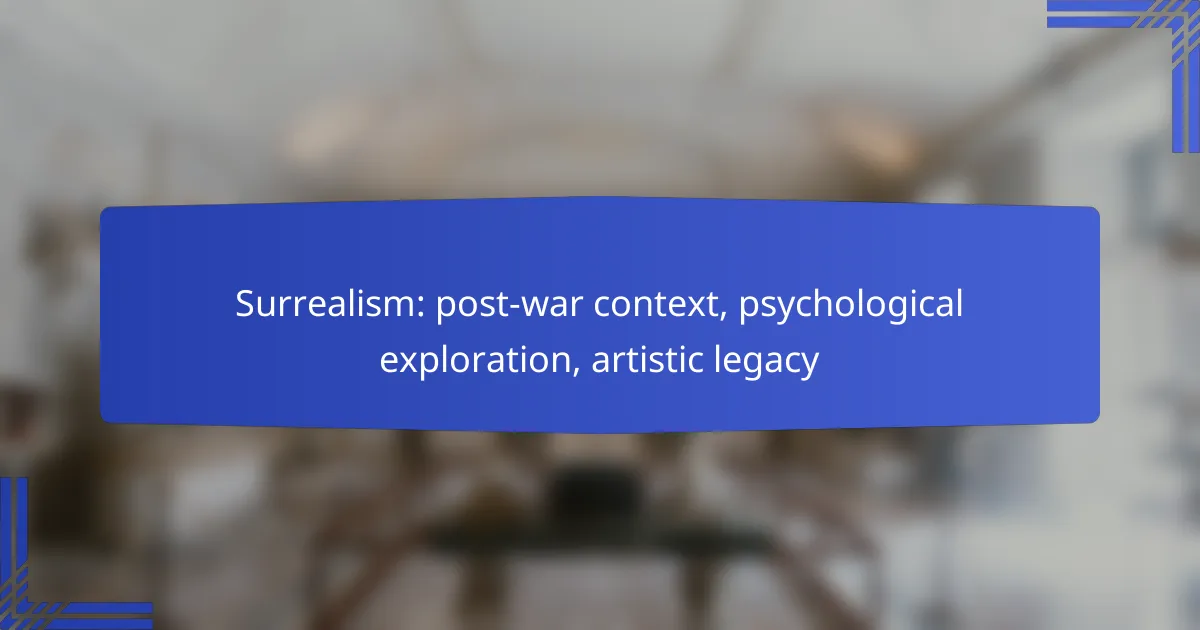Surrealism emerged as a powerful artistic movement in the post-war context, deeply influenced by the trauma and uncertainty following World War II. This period prompted artists to explore psychological themes, delving into the subconscious and the complexities of human emotions, as they sought to express the irrational aspects of thought and experience. The legacy of Surrealism endures in contemporary art, inspiring new generations to challenge perceptions of reality through dream-like imagery and psychological exploration.
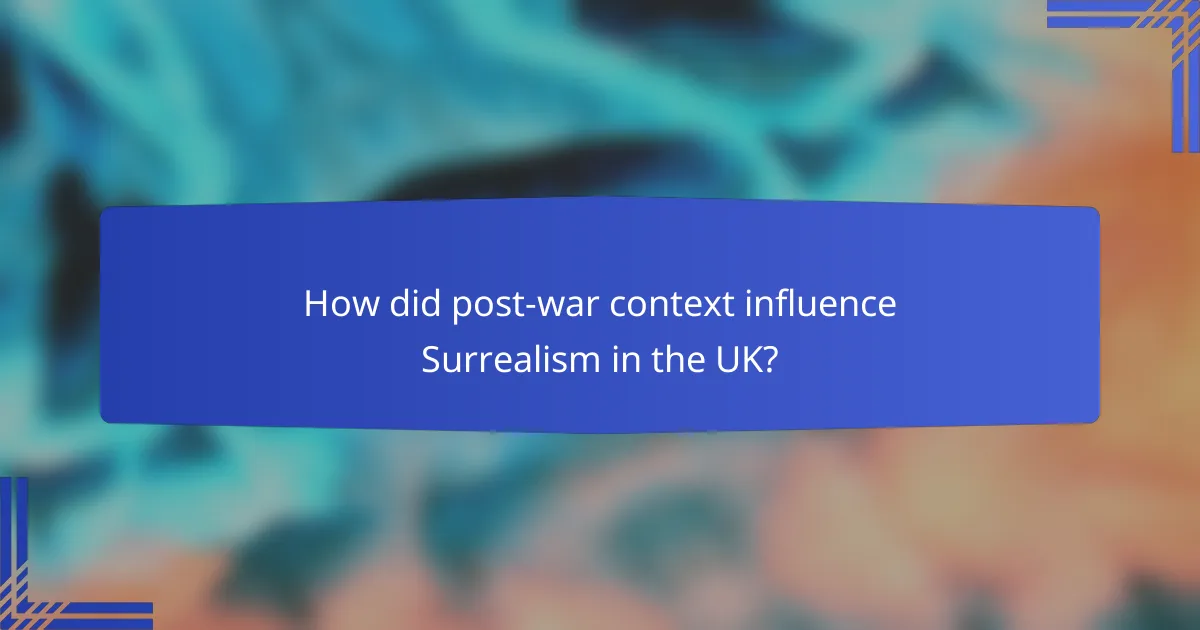
How did post-war context influence Surrealism in the UK?
The post-war context significantly influenced Surrealism in the UK by shaping the themes and expressions of artists responding to the trauma and uncertainty of the era. The aftermath of World War II and the onset of the Cold War prompted a psychological exploration of identity, reality, and the subconscious, which became central to the movement.
Impact of World War II on artistic expression
World War II had a profound impact on artistic expression, as artists grappled with the horrors of conflict and its psychological aftermath. Many British Surrealists used their art to confront the chaos and destruction experienced during the war, often reflecting themes of dislocation and trauma.
For example, artists like Paul Nash and Graham Sutherland incorporated war imagery and surreal landscapes to evoke the emotional scars left by the conflict. This exploration of the subconscious allowed them to express complex feelings that traditional forms of art could not convey.
Role of the Cold War in shaping themes
The Cold War introduced a climate of fear and uncertainty that further influenced Surrealist themes in the UK. The tension between opposing ideologies led artists to explore concepts of paranoia, identity, and the absurdity of existence, often using dreamlike imagery to reflect societal anxieties.
Surrealists like Edward James and Leonora Carrington created works that challenged conventional narratives, using symbolism and fantastical elements to critique the political landscape. This period encouraged a deeper psychological exploration, as artists sought to understand the human condition amidst global instability.
Influence of British culture on Surrealist artists
British culture played a crucial role in shaping the identity of Surrealist artists, blending local traditions with avant-garde ideas. The rich literary heritage of the UK, particularly the works of writers like Lewis Carroll and Samuel Taylor Coleridge, provided a foundation for the Surrealist movement, inspiring artists to explore the boundaries of reality and imagination.
Additionally, the post-war period saw a growing interest in psychoanalysis, particularly the ideas of Freud and Jung, which resonated with British Surrealists. This cultural context encouraged artists to delve into their subconscious, resulting in works that were both personal and reflective of broader societal themes.
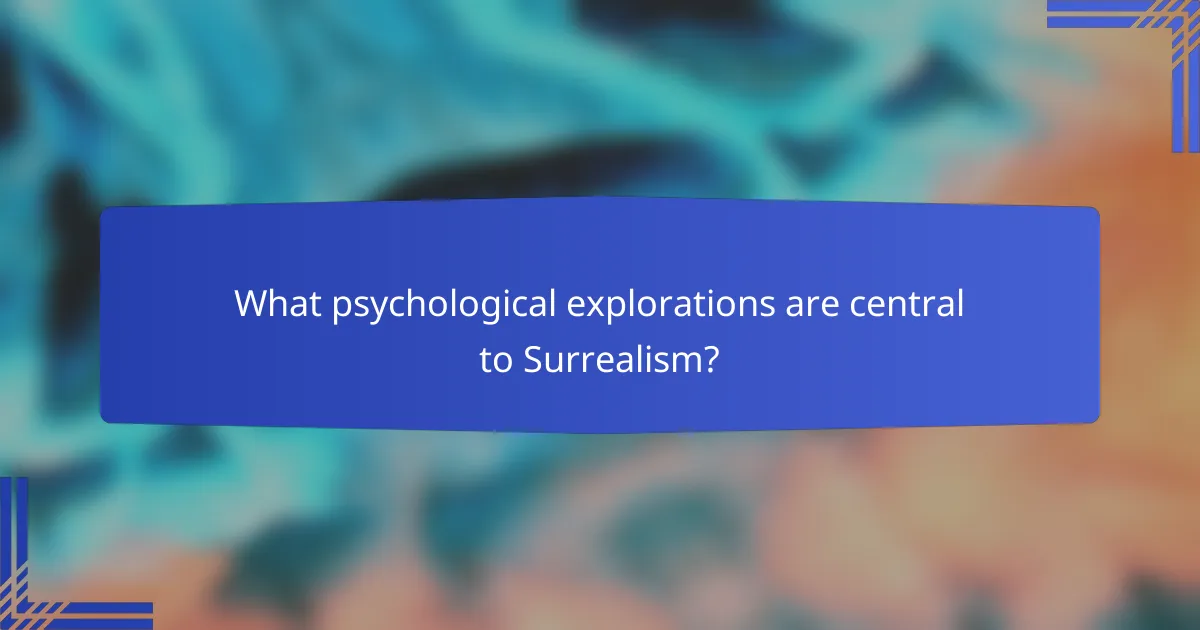
What psychological explorations are central to Surrealism?
Surrealism delves into the psychological realms of the human mind, focusing on dreams, the subconscious, and the complexities of human emotions. This movement seeks to unlock creativity by exploring the irrational and often hidden aspects of thought and experience.
Freudian concepts in Surrealist art
Freudian concepts, particularly those related to the unconscious mind, heavily influence Surrealist art. Artists like Salvador Dalí and Max Ernst incorporated themes of repression, sexuality, and dreams, reflecting Freud’s theories on human behavior. This connection allows viewers to engage with deeper psychological meanings behind the artwork.
For instance, Dalí’s “The Persistence of Memory” illustrates the fluidity of time and memory, echoing Freud’s ideas about the malleable nature of the unconscious. By presenting dream-like scenarios, Surrealists invite audiences to confront their own subconscious fears and desires.
Dream analysis and its artistic representation
Dream analysis is a cornerstone of Surrealist exploration, serving as a gateway to understanding the unconscious. Surrealists believed that dreams reveal hidden truths and emotions, which can be expressed through visual art. This approach encourages artists to depict dream imagery, often characterized by bizarre juxtapositions and unexpected transformations.
For example, René Magritte’s “The Treachery of Images” challenges perceptions of reality by presenting a pipe with the caption “This is not a pipe.” Such works provoke viewers to question their understanding of reality and the dream-like nature of existence.
Subconscious mind as a creative source
The subconscious mind is viewed as a vital source of creativity in Surrealism. Artists aim to tap into this reservoir of thoughts and feelings that lie beneath conscious awareness, believing that it can lead to innovative and authentic expressions. Techniques such as automatic drawing and free association help facilitate this exploration.
By allowing the subconscious to guide their creative process, artists can produce works that resonate on a deeper emotional level. This method encourages spontaneity and originality, often resulting in art that challenges conventional norms and invites multiple interpretations.
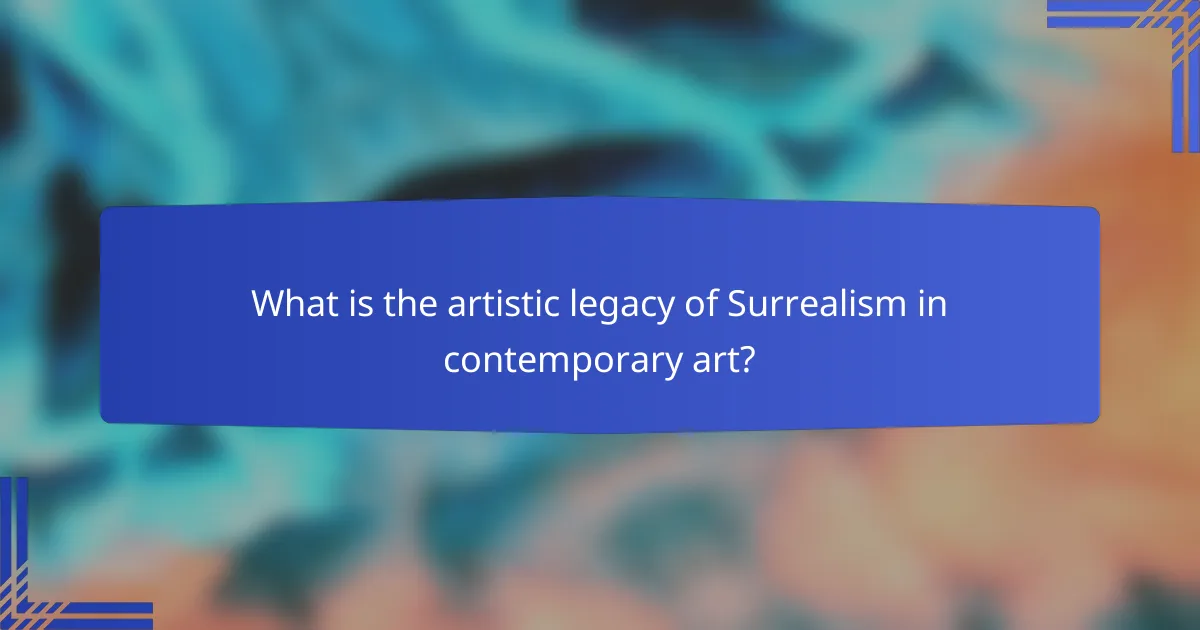
What is the artistic legacy of Surrealism in contemporary art?
The artistic legacy of Surrealism in contemporary art is profound, influencing various mediums and styles. Its emphasis on the subconscious and dream-like imagery continues to inspire artists to explore psychological themes and challenge perceptions of reality.
Influence on modern artists like Damien Hirst
Modern artists such as Damien Hirst draw on Surrealist principles to provoke thought and evoke emotional responses. Hirst’s use of unconventional materials and juxtaposition of life and death reflects the Surrealist fascination with the irrational and the uncanny.
This influence is evident in Hirst’s installations, which often blur the lines between art and reality, encouraging viewers to confront their own perceptions. The legacy of Surrealism allows contemporary artists to explore complex themes in innovative ways.
Surrealism’s impact on film and literature
Surrealism has significantly shaped film and literature, inspiring creators to experiment with narrative structures and visual storytelling. Films like “Eraserhead” and “The Discreet Charm of the Bourgeoisie” showcase dream logic and absurdity, hallmarks of Surrealist thought.
In literature, authors such as Haruki Murakami and Gabriel García Márquez incorporate surreal elements to explore the subconscious and challenge conventional storytelling. This blending of reality and fantasy continues to resonate with audiences, reflecting the lasting impact of Surrealism.
Continuing relevance in digital art
Digital art has embraced Surrealism, utilizing technology to create immersive and dreamlike experiences. Artists leverage digital tools to manipulate images and create fantastical worlds that challenge viewers’ perceptions of reality.
The accessibility of digital platforms allows for a broader exploration of Surrealist themes, enabling artists to reach diverse audiences. As technology evolves, the principles of Surrealism remain relevant, encouraging innovation and experimentation in contemporary artistic practices.

How did Surrealism evolve in the UK after the war?
After World War II, Surrealism in the UK adapted to new cultural contexts, emphasizing psychological exploration and personal experience. Artists began to incorporate elements of British identity and contemporary issues, while maintaining the movement’s core focus on the unconscious mind and dream imagery.
Key movements influenced by Surrealism
Surrealism significantly impacted various artistic movements in the UK, including the Independent Group and the Situationist International. These movements explored the relationship between art and everyday life, often merging surrealist techniques with modernist ideals.
Additionally, the emergence of Pop Art in the 1960s drew on surrealist concepts, using popular culture imagery to challenge traditional artistic boundaries. Artists like Richard Hamilton and Peter Blake incorporated surrealist elements to create provocative works that resonated with contemporary society.
Notable exhibitions and their significance
Several key exhibitions showcased the evolution of Surrealism in the UK, including the 1936 International Surrealist Exhibition in London. This event introduced British audiences to surrealist works and established a platform for local artists to engage with the movement.
Another significant exhibition was “Surrealism: The Dream of the 1930s” held at the Hayward Gallery in 1978, which revisited the impact of surrealism on British art. It highlighted the movement’s lasting influence and its integration into the broader narrative of 20th-century art.

What are the criteria for identifying Surrealist works?
Surrealist works can be identified by their exploration of the unconscious mind, dream-like imagery, and unexpected juxtapositions. Key characteristics include a focus on irrationality, spontaneity, and the use of symbolism to convey deeper psychological meanings.
Common themes and motifs in Surrealist art
Surrealist art often features themes such as dreams, the subconscious, and the juxtaposition of reality with fantasy. Common motifs include distorted figures, unusual landscapes, and everyday objects placed in bizarre contexts, which challenge viewers’ perceptions of reality.
Artists frequently draw on personal experiences, mythology, and the exploration of sexuality and desire. These themes reflect the psychological turmoil and existential questions that arose in the post-war context, making the art deeply resonant with the human experience.
Techniques used by Surrealist artists
Surrealist artists employed various techniques to create their distinctive works, including automatism, collage, and frottage. Automatism involves allowing the subconscious to guide the creative process, resulting in spontaneous and unfiltered expressions of thought.
Collage combines different materials and images to create unexpected relationships, while frottage uses texture to inspire new forms. These methods encourage experimentation and challenge traditional artistic conventions, allowing for a more profound exploration of the psyche.
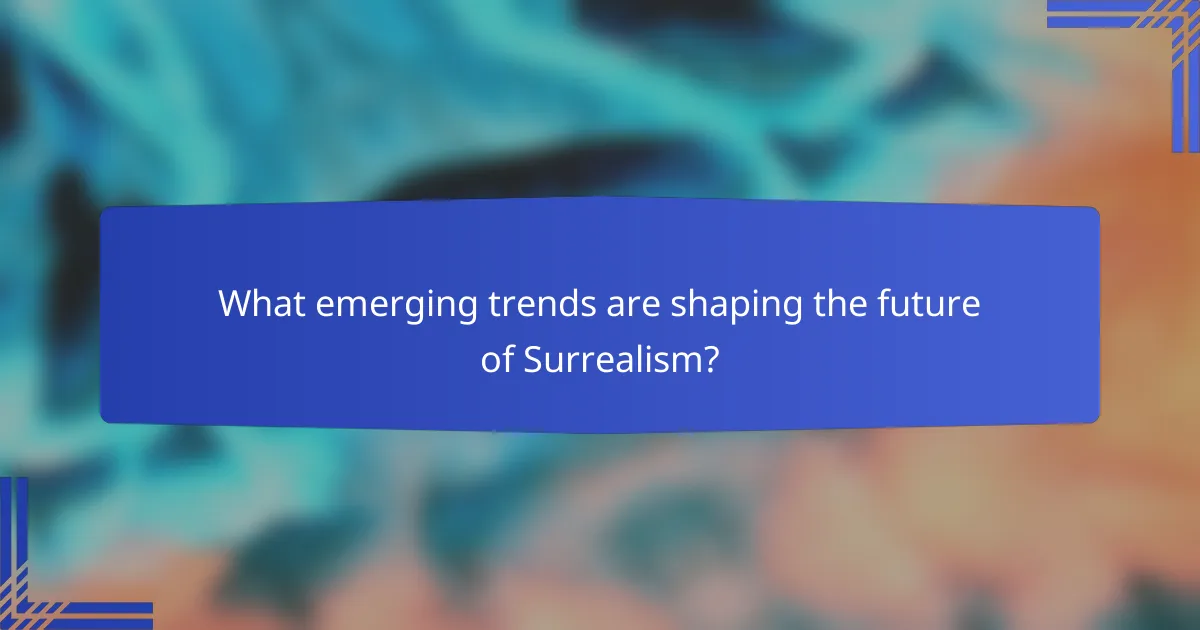
What emerging trends are shaping the future of Surrealism?
Emerging trends in Surrealism are increasingly influenced by digital technology and psychological exploration, reflecting contemporary societal issues. These trends are reshaping how artists express surreal concepts, often merging traditional techniques with modern mediums.
Digital Surrealism and its implications
Digital Surrealism leverages technology to create immersive experiences that challenge perceptions of reality. Artists utilize software tools to manipulate images, generate virtual environments, and explore themes that resonate with the subconscious mind.
This trend has implications for accessibility and audience engagement. Digital platforms allow artists to reach wider audiences, enabling interactive installations and online exhibitions that invite viewer participation. For instance, virtual reality experiences can transport users into surreal landscapes, enhancing emotional connections.
However, artists should consider the balance between digital and traditional methods. While digital tools offer innovative possibilities, maintaining a personal touch through traditional techniques can enrich the artwork’s depth. A common pitfall is over-reliance on technology, which may dilute the emotional impact of the piece.
